
MARS OPPORTUNITY ROVER
LANDS IN LIFE: Part-4 of 4
Report #141
June 15, 2008
Back to: ... PART-1 ..... PART-2 ..... PART-3
This last Part-4 reporting section is going to deal with evidence that is a little less conclusive than that in the previous three sections and a little more speculative. However, there nonetheless should still be fairly obvious once the collective visual evidence is presented.
In the previous Part-1-2-3 sections you've been exposed to the evidence that I have referred to as bags. Yes they almost certainly represent organic matter and therefore life but then the question becomes what kind of life? That isn't as easy to answer but I think there is enough collective visual evidence laying around in this Eagle Crater depression to maybe at least in part answer that question.
You'll remember that I kept suggesting in the previous sections that you pay attention to the soil and its texture. Remember what it looked like and that is in general a very uniform granulated and relatively loose particulate? That is likely in part caused by what ever solid object (small meteor?) struck this area pulverizing the soil to some extent and creating this bowl like depression. With a picture of that soil texture in mind, take a look at the image below.
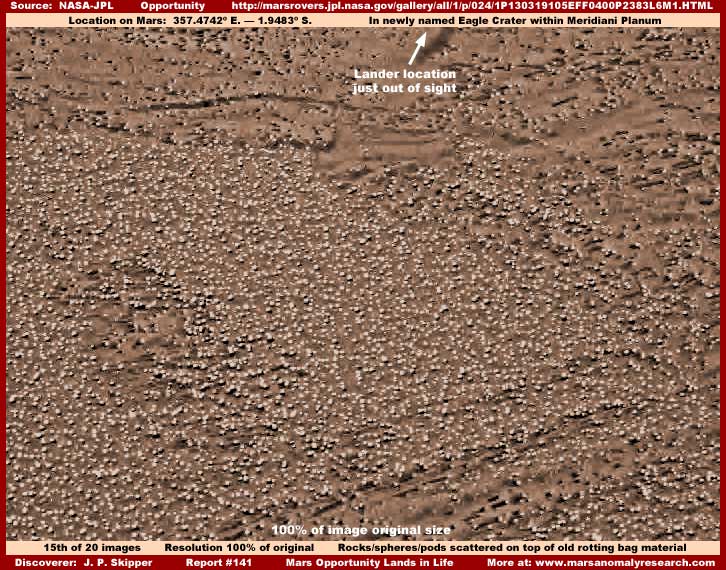
The above 15th image is of a spot also very near the Opportunity Lander within the crater depression. What you are looking at is a very large number of fairly uniform and more sunlight reflective small spheres evenly and densely scattered over this limited area. As you can see, this looks quite different than the normal depression site soil and that is because it is something quite different.
In fact, these spheres are not laying on the soil at all in the above image but on top of older bag material hugging the ground soil. Note the smoother texture of the ground spaces that can be seen here in between where the spheres are not located. The fact that these spheres are on bag material rather than soil can be seen and understood better in the next image below with its wider field of view.
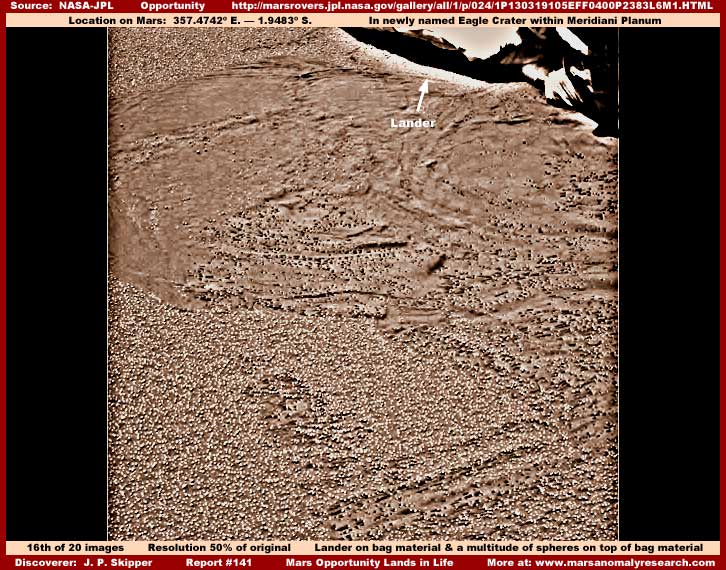
In the above 16th image, you can see the edge of the Opportunity Lander in the very top right of the image. You can also clearly see that the Lander has landed on top of some more of this bag material. Other images not shown here demonstrate that the Lander likely landed on top of a relatively fresh intact large bag collapsing it and likely causing the Lander to stick to the bag material and this spot where the Lander ultimately came to rest. How's that for irony!
Further, I suspect that the bag was full of these spheres that I am now going to start calling pods for the lack of a better term. When the bag burst under the sudden Lander compression weight, the many small pods were expelled outward away from the Lander underside in the scattered but thick density location you see here. However, the bag material you see them on top of here is not the fresher bag that burst under the Lander's weight but an older partially decomposing bag flattened against the ground and already decomposing away in this spot.
Yes, you are getting to it. I am postulating that not only are these bags organic material representing life, I am postulating that they are organic bags of lifting gas that carrying them up into the atmosphere and across the distant Mars terrain on the wind. I am postulated that these bags are a Mars life form's reproductive vehicle carrying these small spheres or pods in large numbers in each bag to deposit their load in distant locations like this spot in what we've named Eagle Crater.
I am thinking that the basic design principle is for these bags to burst higher in the atmosphere scattering the many pods to free fall to the ground and that the bag vehicle remnants then flutter down to the ground where they eventually rot away on the surface. I am thinking further that the Mars life forms generating these reproductive vehicles are a life form subject to the difficulties of the Mars environmental conditions and are not artificial factories that replicate these vehicles exactly the same every time.
That logically means that not all bags are the same and not all reach their intended design goals. Some burst high and scatter their load when the conditions (wind, temperature, sunlight, etc.) are ideal for that and the delivery vehicle is as healthy as it needs to be. In other less favorable health and environmental conditions, the bags burst low in the atmosphere not too far above ground and some sink to the ground intact with their load and deteriorate there.
I suspect the later scenario is what happened in this Eagle Crater depression not too long before the Lander arrived. The Lander managed to bounce into this depression right on top of one of these more or less intact only partially inflated bags. The bag cushioned the Lander's landing and caused it to stick to this spot on top of the bag (the bag blew out sideways) rather than bounce on around some more in the confining depression. That is why in the context scene of Eagle Crater with the Lander in it, you do not see any bounce or roll impressions (not a single one) in the loose granulated soil before the Lander came to rest.
Let's face it, we were likely suppose to think that the various patches of organic bag remnant material laying around in the depression and around the Lander were Lander bag bounce impressions and be satisfied with that distantly viewed evidence. In other words, we weren't suppose to look closer or put the collective bits and pieces together. Yet, here it is several years later and, just when they think they're home free, here comes some idiot who did look closer. I can just hear it now, "it just isn't fair" from the secrecy crowd and "it just can't be" from the I don't want to be disturbed crowd.
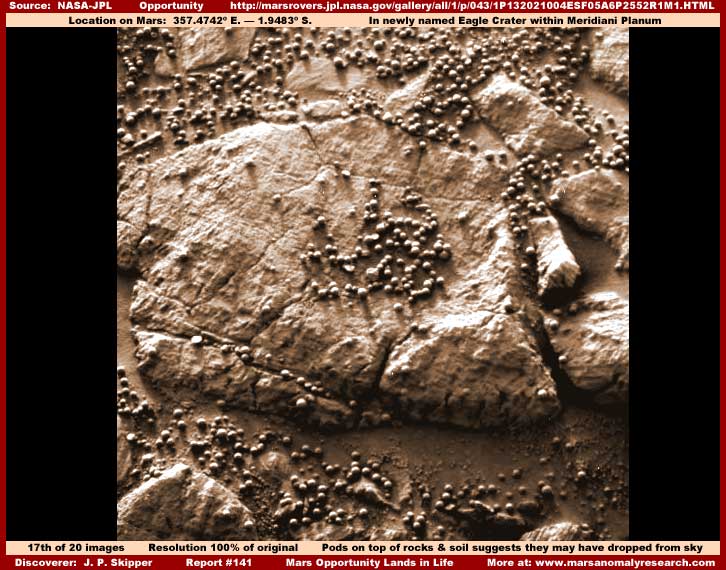
The above 17th image is a bit closer view of some of the sphere/pods in the Mars terrain. These rocks in evidence under the pods are likely at the rim of the Eagle Crater depression taken on Mars Sol day 043 while the rover was still poking around the depression area. Note that this scene is taken with the panoramic camera no doubt bending over for a closer look and is not an image by the onboard microscopic camera. Although I do not trust the official statistics, this view gives one a slightly better impression of pods size scale.
Note how nice and clean and smooth this evidence is and therefore how light reflective they are relative to the soil and rocks upon which they rest. Note how little evidence there is of any of these objects being partially buried in the underlying soil and how they sit right on top of everything. It is as though they were just dropped out of the sky on this spot recently and that is probably because that is likely the truth.
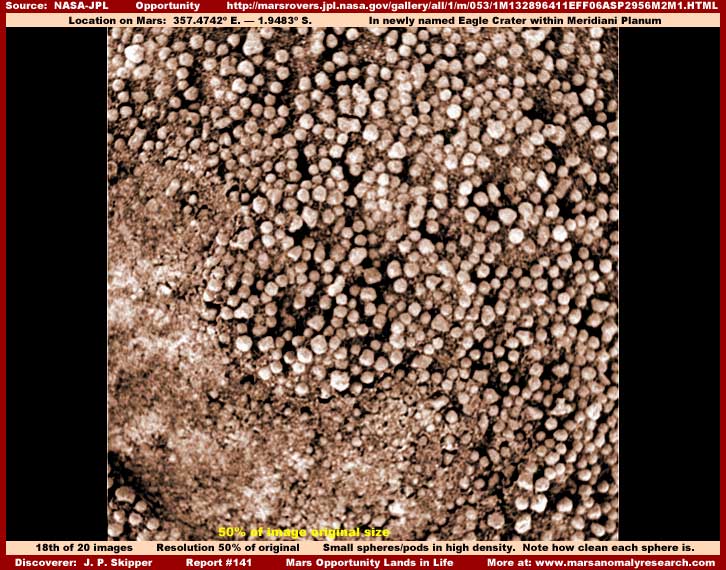
The above 18th image is a scene from the microscopic camera of a different high density area taken on Sol 053 while the rover was still in the Eagle Crater depression area. Now these pods do not look much bigger than in the previous 17th image but that is because I've reduced the original size image by 50% causing them to appear more distant and smaller than they actually are. I thought it more appropriate that you see the larger scene rather than a tighter focus on only a portion of it. The next image below will provide a tighter closer focus.
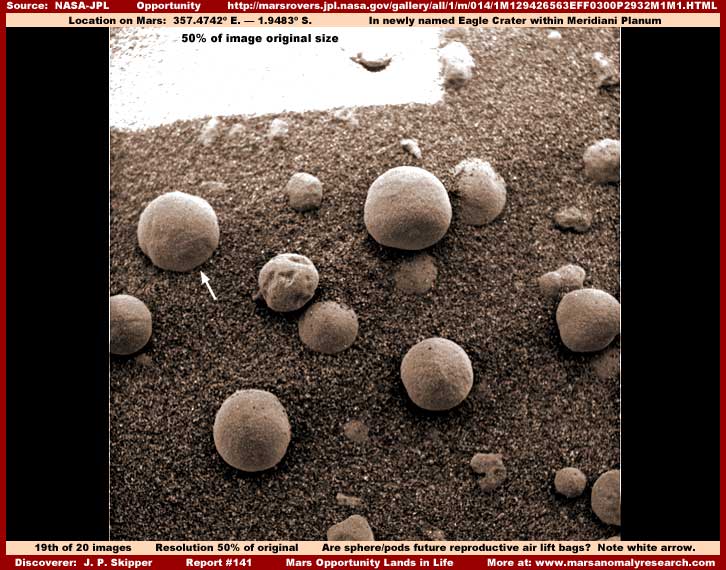
The above 19th image is also from the microscopic camera and demonstrates a closer view of some pod evidence in the shadow of the rover. This one is better because most of the scene is in mild shadow and pod and soil details can be brought out better without all the glaring sunlight reflectivity off of them to contend with.
Even so, in this scene and in my opinion, the smaller round spherical pods are the true size of the pods as dropped to the ground from the bag vehicles but the larger fuller pods are different and represent an increasing growth stage. I suspect that these larger growths are not necessarily the smaller pods on top of the ground growing, but represent a larger life form underground that is blooming and what we are seeing here is the very beginning infant stages of the bloom formation of the gas bag reproductive vehicles coming up to the surface from below.
Note the growth on the left edge pointed out with the white arrow. I could be wrong but that suspiciously appears very similar to the formation of a future bag round end seam on the left near side and the faint beginnings of around the bag longer seam striations over the main body. While looking at this image, please also note the very uniform granulation of the soil.
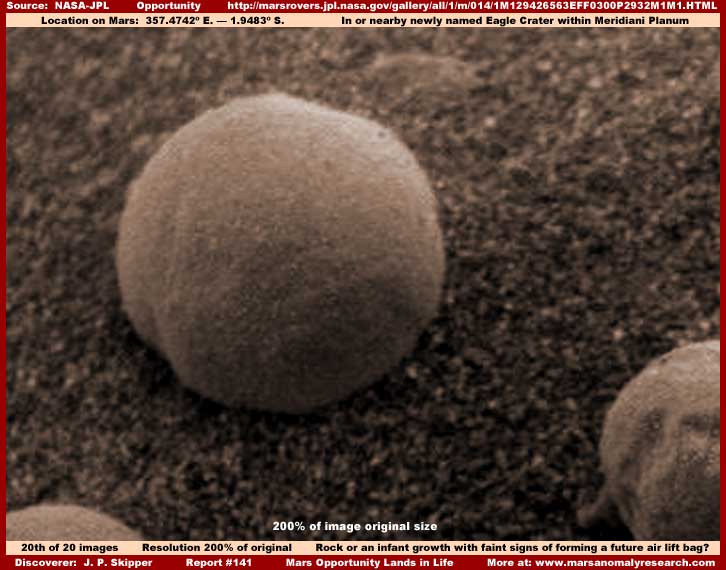
The above 20th image demonstrates a much closer view of the single growth pointed out by the white arrow in the 19th image as well as of course the soil. The suggestion is that here is a future bag formation via the faint striation seams forming on the swelled surface of this object but it is very faint and you will have to judge for yourself.
Now look in the lower right corner at that some what deformed growth also seen fully in the 19th image. Most of these images, including this one, pretty much look straight down on these objects rather than using any oblique angles so that we can see more under them that might be more informative to us. In doing doing so, this mostly precludes determining whether there is any underlying stem or future tether that might for example reveal this as a growth rather than say just a round smooth rock sitting there.
However, note that this lower right corner object has multiple deformations or indentions on its surface and is likely not as healthy as the others fully inflated objects. That suggests poor health and some possible deterioration showing up on its surface as its inflation quality is diminishing. It is possible that this is a less healthy object no longer pushing upright but leaning over to the side slightly. In doing so, although this isn't conclusive, it may be showing us just a part of an underlying stem.
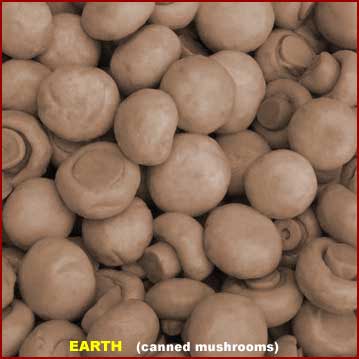
The above 21st image is of some mushrooms prepared for canning here on Earth. Now I'm not exactly suggesting that what we are looking at on Mars is some kind of mushroom life. I'm just including this to show you how some of the Mars visual evidence can look so much like this Earth based life. Also, unlike a Earth factory producing the same kind of canned goods over and over off of a production line that all look alike, life produces evidence that is all very similar looking but not all exactly alike and with imperfections.
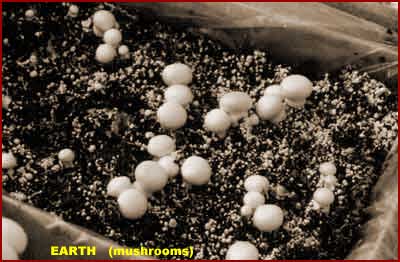
The above 22nd image is again of some of the same kind of Earth mushrooms but in growing media conditions. Note how the camera oblique angle view helps determine that they are growth and life on stems. On the other hand, if the view had been straight down on these Earth mushrooms and then this evidence had been purported to be on Mars, one would have to identify them as something neutral like spheres, balls or globes even though they are life. This is how a simple camera angle or the lack of it can introduce ambiguity into evidence rendering it questionable as to whether it is life or geology.
While we're on the subject of Earth mushrooms, you need to understand that even this kind of Earth evidence can be far more than you ever imagined and most definitely more than what you've seen in the supermarket or restaurant. Take a look at the links below.
http://www.sciam.com/article.cfm?id=strange-but-true-largest-organism-is-fungus
http://www.infoplease.com/spot/fungus1.html
http://news.softpedia.com/news/Anceint-Mushrooms-Were-As-Big-As-Trees-52720.shtml
A single underground organism covering 2,364 acres or almost 4-square miles weighing in the many hundreds of tons and thousands of years old? Further, additional research has determined that these creatures are apparently genetically closer related to human beings and animals than to plants. WHAT!!! And that's right here on Earth rather than Mars.
When such an underground gigantic organism here on Earth decides to reproduce, there is a type of above ground bloom evidence that we call mushrooms. Most often, the mushroom blooms cast spores in a reproductive process known as Anemochory or wind dispersal. Inherent in this process is the production and dispersal of great numbers of tiny reproductive components like spores or seeds.
With this kind of known information grasped, why then would it be so strange to consider that an underground life form adapted to Mars conditions on the Meridiani plain could develop similar but also different reproductive methodologies on this distant world? Instead of an above ground but still low to the ground mushroom like reproductive elevated device in relatively level plain locations such as the Lander area of Mars, what about the development of a reproductive gas bag vehicle on a tether reaching higher elevation. A chemical reaction within the bag exacerbated by temperature and sunlight heat energy could provide the lift. The bag might be designed to tear loose from the tether in a certain degree of strong wind conditions and become airborne on the wind.
The spore or seed could be embedded in a tough but light weight rounded organic pellet or pod material that could provide eventual fertilizing growth nutrients in the decomposition stage. The ideal is that, when the dying bag bursts open along the weakened seam lines, individual pellets or pods drop from a considerable height in large numbers to hopefully via momentum bury up in the granulated soil and start the life cycle all over again.
When the conditions are not ideal and/or the bag not fully healthy to its design and/or the bags are too low in altitude and/or the soil too hard to penetrate, the pods lay around on the surface doing nothing and eventually decompose. But, remember, success is in the sheer numbers of bags and pods produced and distributed. Those pods not productive and bag material are merely absorbed back into the terrain providing more general nutrients to the soil and any life in it including the originators of the reproductive bags and pods.
If one can divorce one's emotions (feelings) and pre-conclusions of what is or is not possible out of the equation, this is logical conjecture extrapolated from the much more conclusive organic bag evidence and reasonable. Is it really so hard to grasp once one understands the bag evidence better and all these multitude of tiny spheres present in certain areas of the crater depression sitting on top of and likely orphaned on this granulated soil surface? Is it really easier to make the stretch that these great multitude of spheres laying around are the result of for example chemical reactions in the geology of this uniform granulated soil and are now just uniform rocks?
In any case, I've put forth this evidence in this longer reporting trying to convey it as best I can in this style. The bag visual evidence is essentially conclusive on its own merit as to life on Mars while the pod visual evidence is dependent on the bag evidence and therefore more interpretive. However, it points the way for you scientists to pick up the ball on. If you are not inclined to do so, remember that millions are now watching and paying attention to what you do and/or do not do and time is running out for denial and procrastination.
ADDENDUM .. 6/19/2008
I'm getting email feedback from a few viewers pointing out that the patches on the ground within Eagle Crater and around the Opportunity Lander are impressions left by the Lander cushion bags as the Lander bounced around in this depression before settling down. This issue depends on whether you wish to believe the visual evidence presented here and your own eyes or not. Although this question was anticipated and attended to already in this report's visual evidence as well as in the narrative, here we go again.
I can't know for sure but I suspect this question in some viewer's minds likely means that they are encountering this dismissal factor in discussion forums by "informed sounding" individuals and it sounds reasonably plausible to them. It may sound relatively plausible but it is not truth, it is not backed by the visual evidence, and this is a matter of the visual evidence, not opinion or conjecture.
A number of times in this four part report, I kept drawing the viewer's attention to the soil and its texture to familiarize the viewer with what the true soil looks like. In the visual evidence presented, the patches around the Lander in this depression are very clearly a substance or material on the ground surface covering and obscuring the underlying true soil visuals. Note that substance is even complete with folds in the material and in pieces flattened against the soil inconsistent with bounce impression and in various states of decomposition. There is nothing in this that can be confused with fresh at that time Lander bag bounce compression impressions.
Likewise, please note the visual evidence in images 15 and 16 at the top of this Part-4. Note that the many spheres or pods show absolutely no signs of bounce compression into the material that they are resting on. In fact, remember what the soil texture looks like and then note that the many pods are laying on top of some of this very same bag material plastered against the ground and demonstrating folds in its smoother than the true soil surface and is clearly a material substance under and between the pods and the soil itself.
This is simply a matter of visual evidence, not opinion or conjecture no matter how plausible it may sound to some. The straight forward visual evidence tells one what one needs to know. If it does not for some, that is more likely a matter of psychology and belief system rather than objective hard visual evidence. I can only present the evidence and beyond that it is up to the viewer to recognize it or not.
Back to: ... PART-1 ..... PART-2 ..... PART-3
DOCUMENTATION
http://marsrovers.jpl.nasa.gov/gallery/all/1/p/024/1P130319105EFF0400P2383L6M1.HTML: This link takes you to the official science data image for verification that my above 15th and 16th report images are sourced from.
http://marsrovers.jpl.nasa.gov/gallery/all/1/p/043/1P132021004ESF05A6P2552R1M1.HTML: This link takes you to the official science data image for verification that my above 17th report image is sourced from.
http://marsrovers.jpl.nasa.gov/gallery/all/1/m/053/1M132896411EFF06ASP2956M2M1.HTML: This link takes you to the official science data image for verification that my above 18th report image is sourced from.
http://marsrovers.jpl.nasa.gov/gallery/all/1/m/014/1M129426563EFF0300P2932M1M1.HTML: This link takes you to the official science data image for verification that my above 19th and 20th report images are sourced from.
, Investigator
![]()